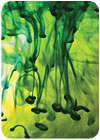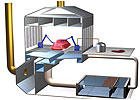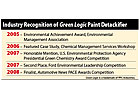A Green Detackifier for Paint Sludge
Two of the industry’s most frequently used paint detackifiers are based on either melamine-formaldehyde or an acrylic acid. Melamine-formaldehyde-based detackifiers contain small amounts of residual-free formaldehyde and are derived from nonrenewable natural gas reserves. The acrylic acid-based group of paint denaturants is derived from ethylene and/or propylene produced during the petroleum cracking process and therefore relies on nonrenewable petroleum-based feedstocks. Recently, a new paint detackifier has been developed that provides an environmentally responsible alternative.

 In traditional automotive manufacturing wet paint-spraying operations, only 50 to 80% of the paint actually reaches the vehicle. The remaining 20 to 50% is carried away in the booth airstream and subsequently removed by the recirculating water wash (see Figure 1). Paint denaturants, also referred to as “paint detackifiers,” are added to the water wash to detackify (make it nonsticky), coagulate and flocculate this oversprayed paint, enabling it to be removed from the water in either a continuous or batch process.
In traditional automotive manufacturing wet paint-spraying operations, only 50 to 80% of the paint actually reaches the vehicle. The remaining 20 to 50% is carried away in the booth airstream and subsequently removed by the recirculating water wash (see Figure 1). Paint denaturants, also referred to as “paint detackifiers,” are added to the water wash to detackify (make it nonsticky), coagulate and flocculate this oversprayed paint, enabling it to be removed from the water in either a continuous or batch process.
Two of the industry’s most frequently used paint detackifiers are based on either melamine-formaldehyde or an acrylic acid. Melamine-formaldehyde-based detackifiers contain small amounts of residual-free formaldehyde and are derived from nonrenewable natural gas reserves. The acrylic acid-based group of paint denaturants is derived from ethylene and/or propylene produced during the petroleum cracking process and therefore relies on nonrenewable petroleum-based feedstocks. Consequently, the pricing of these acrylic acid-based products is subject to the volatility in the energy market.
Recently, a new paint detackifier* has been developed that provides an environmentally responsible alternative.

The chitosan-containing paint detackifier has been named “best in class” by OEM users and nominated for many environmental awards because it helps automakers realize performance gains in paint detackification and overall paint spray booth operations. It also offers greater ease of operation and savings from reduced spray booth maintenance, ancillary chemicals, wastewater treatment and disposal costs. Moreover, the paint sludge generated by the new paint detackifier is more amenable to biodegradation.
The chitosan-containing detackifier was developed between 1999 and 2002 at PPG’s Total Service Solutions Specialty Products laboratories in Troy, MI, and the formula was further refined between 2005 and 2006. The innovation resulted from PPG’s ongoing efforts to bring value-added products and services to the market that help industry minimize or eliminate its impact on the environment.
Although this innovation was not developed to meet a specific current or future government mandate, it was driven by the market’s increasing recognition of the need to preserve nonrenewable natural resources. Accordingly, the chitosan-containing paint detackifier provides OEMs with a solution formulated from renewable natural resources (crab, lobster and shrimp shells), as opposed to petroleum-based (acrylic acid) or natural gas-derived (melamine-formaldehyde) polymers. In addition, the new paint detackifier obviates the safety concerns raised with regard to the free formaldehyde that can be present in melamine-formaldehyde-based technologies.
The chitosan-containing paint detackifier meets or exceeds OEM requirements for paint detackification, ease of use, and sludge weight and volume generated, and it is being used successfully in the marketplace.

The chitosan-containing paint detackifier has met specifications easily in systems in which it has been implemented. The immediate benefit is that fewer solids are returned to the paint spray booth, which reduces labor costs incurred for booth maintenance. In addition, this technology has reduced total dissolved solids, biological oxygen demand, chemical oxygen demand, and corrosion rate of the water in water wash systems - all of which lead to savings on wastewater treatment costs.
The new paint detackifier changes the game by providing automakers with an environmentally responsible technology that offers performance gains, greater ease of operation and overall system cost savings. When consumers buy a vehicle from an OEM using the chitosan-containing paint detackifier, they can be assured the automaker is doing everything it can to reduce its environmental impact, right down to choosing a “greener” way to dispose of its paint sludge.
*The new paint detackifier is commercially available as Green Logic, a trademark of PPG Industries. For more information, visit www.ppg.com.


Figure 1. A typical automotive downdraft, water-washed paint spray booth.
Two of the industry’s most frequently used paint detackifiers are based on either melamine-formaldehyde or an acrylic acid. Melamine-formaldehyde-based detackifiers contain small amounts of residual-free formaldehyde and are derived from nonrenewable natural gas reserves. The acrylic acid-based group of paint denaturants is derived from ethylene and/or propylene produced during the petroleum cracking process and therefore relies on nonrenewable petroleum-based feedstocks. Consequently, the pricing of these acrylic acid-based products is subject to the volatility in the energy market.
Recently, a new paint detackifier* has been developed that provides an environmentally responsible alternative.

The new paint detackifier is a liquid, chitosan-containing technology that is derived from crab, lobster and shrimp shells, which are natural waste products of food production.
A Renewable Alternative
The new paint detackifier is a liquid, chitosan-containing technology that is derived from crab, lobster and shrimp shells, which are natural waste products of food production. As such, the innovation incorporates renewable natural resources in its formulation.The chitosan-containing paint detackifier has been named “best in class” by OEM users and nominated for many environmental awards because it helps automakers realize performance gains in paint detackification and overall paint spray booth operations. It also offers greater ease of operation and savings from reduced spray booth maintenance, ancillary chemicals, wastewater treatment and disposal costs. Moreover, the paint sludge generated by the new paint detackifier is more amenable to biodegradation.
The chitosan-containing detackifier was developed between 1999 and 2002 at PPG’s Total Service Solutions Specialty Products laboratories in Troy, MI, and the formula was further refined between 2005 and 2006. The innovation resulted from PPG’s ongoing efforts to bring value-added products and services to the market that help industry minimize or eliminate its impact on the environment.
Although this innovation was not developed to meet a specific current or future government mandate, it was driven by the market’s increasing recognition of the need to preserve nonrenewable natural resources. Accordingly, the chitosan-containing paint detackifier provides OEMs with a solution formulated from renewable natural resources (crab, lobster and shrimp shells), as opposed to petroleum-based (acrylic acid) or natural gas-derived (melamine-formaldehyde) polymers. In addition, the new paint detackifier obviates the safety concerns raised with regard to the free formaldehyde that can be present in melamine-formaldehyde-based technologies.
The chitosan-containing paint detackifier meets or exceeds OEM requirements for paint detackification, ease of use, and sludge weight and volume generated, and it is being used successfully in the marketplace.

Industry Recognition of Green Logic Paint Detackifier
A Cost-Saving Solution
The product was beta-tested in August 2005 and first launched at an automotive assembly plant on May 8, 2007. Its continuing success has led to subsequent launches at multiple OEM assembly locations.The chitosan-containing paint detackifier has met specifications easily in systems in which it has been implemented. The immediate benefit is that fewer solids are returned to the paint spray booth, which reduces labor costs incurred for booth maintenance. In addition, this technology has reduced total dissolved solids, biological oxygen demand, chemical oxygen demand, and corrosion rate of the water in water wash systems - all of which lead to savings on wastewater treatment costs.
The new paint detackifier changes the game by providing automakers with an environmentally responsible technology that offers performance gains, greater ease of operation and overall system cost savings. When consumers buy a vehicle from an OEM using the chitosan-containing paint detackifier, they can be assured the automaker is doing everything it can to reduce its environmental impact, right down to choosing a “greener” way to dispose of its paint sludge.
*The new paint detackifier is commercially available as Green Logic, a trademark of PPG Industries. For more information, visit www.ppg.com.
Looking for a reprint of this article?
From high-res PDFs to custom plaques, order your copy today!





